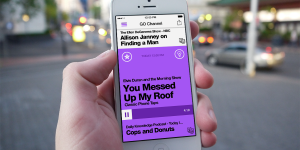 Tech
Tech
APP OF THE MONTH: Pop Sandbox's Pipe Trouble
by Mark Teo
May 6, 2013
In the weeks following its release, Pipe Trouble was called many things: Right-wing media called it a tribute to eco-terrorism. Alberta premier Alison Redford called it a “disappointing” use of Ontario public funding. Sun TV pundit Ezra Levant turned it into a regional debate, saying it was “as if the Alberta or British Columbia. government paid for a game called Windmill Bomber—hey, go bomb those windmills in Ontario.” Yeesh.
In the weeks following its release, Pipe Trouble was called many things: Right-wing media called it a tribute to eco-terrorism. Alberta premier Alison Redford called it a “disappointing” use of Ontario public funding. Sun TV pundit Ezra Levant turned it into a regional debate, saying it was “as if the Alberta or British Columbia. government paid for a game called Windmill Bomber—hey, go bomb those windmills in Ontario.” Yeesh.
But for all the controversy that surrounded it—around gaming literacy or the role of public arts funding—Pipe Trouble isn’t a radical political statement; it’s a freely available game (or tablet app). And it’s one you’re likely familiar with. Like Pipe Mania or Bioshock, it’s a 2-D pipeline puzzle game. But it has a unique setting: Pipe Trouble players connect oil pipelines through rural BC. Build too slowly, and a rush of gas will destroy farmland. If you build atop trees, expect to hear from environmental protesters. Use too much piping—and, by extension, too much money—and expect to hear from upset oil-industry developers. Then, if you build too mindlessly, expect graffiti or, at worst, a pipeline bombing (which, uh, isn’t exactly fiction).
In truth, Pipe Trouble doesn’t proselytize: It’s about asking questions—not providing answers—about how the energy industry balances environmental and financial concerns. It’s about creating a conversation about sometimes-stuffy Canadian current affairs—and having fun in the process. We spoke with Alex Jansen, who helms Pop Sandbox—the multimedia org responsible for the game, along with Kenk, a journalistic graphic novel about Toronto bike theif Igor Kenk—to talk about the buzz surrounding Pipe Trouble.
AUX: How did you develop Pipe Trouble?
Alex Jansen: It’s tied to a documentary, Trouble in the Peace, which looks at the Peace River region of BC. It follows one farmer, who’d largely be struggling with farming as a way of life, except he’s subsidized by big oil and gas. He’s got a gas line on his property. But he’s torn, and around the time his daughter is born, there’s a big leak in the area, then he had a two-headed calf born on his property that he was convinced was related to the leak. For him, it’s the start of these larger concerns around safety and the environment. Then, the backdrop to the film is the series of bombings that begin to happen—between 2008 and 2010, there were six in the region.
So we [at Pop Sandbox] were approached about doing an interactive extension that would engage a different-than-traditional 90-minute doc audience. That’s why we looked at exploring video games. We took the mechanic of the classic games Pipe Dream and Pipe Mania, where you had these random pieces of pipe connecting from a start point to end point. It’s a familiar and easy-to-grasp mechanic, but [with Pipe Trouble], you’re building on top of farmlands, forests, and rural communities in increasingly over-the-top, cartoonish situations. In the process, you’re able to layer in real-world issues.
At the same time, you don’t get preachy.
No. You have to balance financial and environmental concerns—on one side, you have big oil and gas pressuring you to take the most direct route to build pipe, but on the other, you have this small-town farmer raising ethical and environmental concerns. It’s a caricature, but as a player, you begin to see how complex it is to navigate both sides. It’s a start point, not an end point for these issues—it drives [players] to realize what’s happening in these remote regions. It doesn’t tell people what to think, but it tells people to think. And these issues are pertinent to all Canadians.
Yet TVO, who provided funding for the project, pulled the game from their site, even if they’re still carrying Trouble in the Peace?
It’s a funny situation. The whole thing escalated when Pipe Trouble was brought up to the Ontario Premier [Kathleen Wynne] at a media scrum. It was positioned—unfairly—as this publicly funded eco-terrorism game about bombing pipelines. And the next thing you know, you had these articles in the Toronto Sun saying, “Pipeline propaganda! You, too, can play eco-terrorist!”
It was a lot of misinformation, and that same misinformation moved through government and the media, which could’ve been dispelled through playing the game. It got to the point that people started to form incredibly strong opinions — the mayor of Dawson Creek, BC, demanded a formal apology, [despite] having admittedly never played the game. It’s like deciding to burn a book before you’ve ever read it.
Which is funny, because the game’s more open-ended than Trouble in the Peace, which seems to be more direct in its messaging.
It surprises me, because I thought the dialogue was a lot further along than it is.
What’s happening with video games now is what happened with comics: You have a medium that’s being confused with a genre. It’s not that Pipe Trouble is trailblazing; it’s not the first project to explore these issues. It’s frustrating, because we live in a country where almost all of our art is [government] funded in one form or another. There’s so many different types of projects being funded, and it’s acceptable to look at some issues in traditional journalism, print, or within documentary film, but it’s not acceptable to look at them in video games.
So how’d you get Fucked Up involved in the score? The whole thing sounds like a Hidden World b-side.
It wasn’t the whole band—it was Mike [Haliechuk, guitarist] and Jonah [Falco, drummer]. We were talking with them about Kenk, because we’re doing an animated film for the graphic novel, and there’s a mutual respect for each other’s work. It was an interesting collaboration—as you build pipes, you begin to build the score, which progressively becomes more like noise pollution.
It’s pretty exciting to work together, and we’re working on a music mashup game they’ll be central in, too, so hopefully that’ll be [Pop Sandbox’s] next project.
Beyond the media, what’s the feedback for the game been like?
It’s really been working with that 18-35 audience—and if you look at the stats, the average gamer is 30 years old, 70 per cent of gamers are over 18, and there are actually more adult women playing that adolescent men. It’s been really neat, because we’re really engaging this audience that historically has the single worst voter turnout and [doesn’t engage with] public policy.
We ask this to everyone we feature as the app of the month, but it might seem like a strange question for you: How do you cut through the noise of the app store?
[Laughs] I don’t know man. I’d like to give positive advice, but I don’t know if we’ve mastered that. I would say one of the things that’s been helpful is getting arcade cabinets—it [established] a physical presence. We’re reaching an audience by taking the game on the road—we’ve taken them to Fucked Up’s Long Winter, [Toronto old-school gaming haunt] Get Well, University of Toronto, the Toronto Comicon, SXSW… It gives people something physical to anchor the game to.
This article originally appeared in the May 2013 issue of AUX Magazine. Download and subscribe for free in the App Store.
Tags: Tech, Interviews, News, Alex Jensen, App of the Month, AUX Magazine, Damian Abraham, Fucked Up





